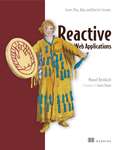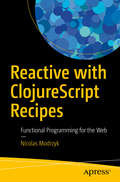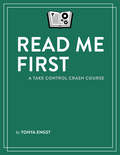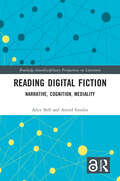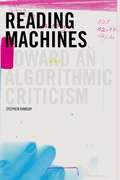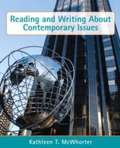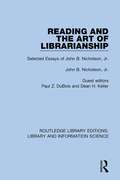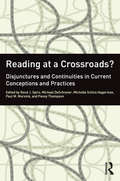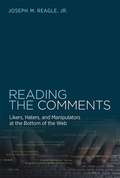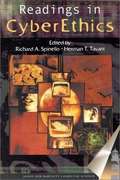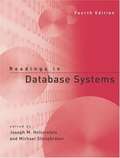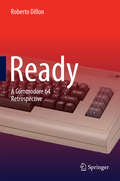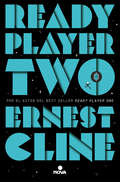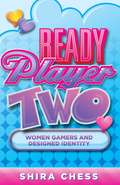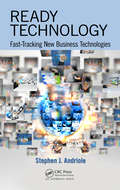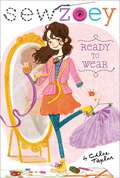- Table View
- List View
Reactive Systems in Java: Resilient, Event-Driven Architecture with Quarkus
by Ken Finnigan Clement EscoffierReactive systems and event-driven architecture are becoming indispensable to application design, and companies are taking note. Reactive systems ensure that applications are responsive, resilient, and elastic no matter what failures or errors may be occurring, while event-driven architecture offers a flexible and composable option for distributed systems. This practical book helps Java developers bring these approaches together using Quarkus 2.x, the Kubernetes-native Java framework.Clement Escoffier and Ken Finnigan show you how to take advantage of event-driven and reactive principles to build robust distributed systems, reducing latency and increasing throughput, particularly in microservices and serverless applications. You'll also get a foundation in Quarkus to help you create true Kubernetes-native applications for the cloud.Understand the fundamentals of reactive systems and event-driven architectureLearn how to use Quarkus to build reactive applicationsCombine Quarkus with Apache Kafka or AMQP to build reactive systemsDevelop microservices that utilize messages with Quarkus for use in event-driven architecturesLearn how to integrate external messaging systems, such as Apache Kafka, with QuarkusBuild applications with Quarkus using reactive systems and reactive programming concepts
Reactive Web Applications: Covers Play, Akka, and Reactive Streams
by Manuel BernhardtSummaryReactive Web Applications teaches web developers how to benefit from the reactive application architecture and presents hands-on examples using the Play framework.Purchase of the print book includes a free eBook in PDF, Kindle, and ePub formats from Manning Publications.About the TechnologyReactive applications build on top of components that communicate asynchronously as they react to user and system events. As a result, they become scalable, responsive, and fault-tolerant. Java and Scala developers can use the Play Framework and the Akka concurrency toolkit to easily implement reactive applications without building everything from scratch.About the BookReactive Web Applications teaches web developers how to benefit from the reactive application architecture and presents hands-on examples using Play, Akka, Scala, and Reactive Streams. This book starts by laying out the fundamentals required for writing functional and asynchronous applications and quickly introduces Play as a framework to handle the plumbing of your application. The book alternates between chapters that introduce reactive ideas (asynchronous programming with futures and actors, managing distributed state with CQRS) and practical examples that show you how to build these ideas into your applications.What's InsideReactive application architectureBasics of Play and AkkaExamples in ScalaFunctional and asynchronous programmingAbout Reader DescriptionFor readers comfortable programming with a higher-level language such as Java or C#, and who can read Scala code. No experience with Play or Akka needed.About the AuthorManuel Bernhardt is a passionate engineer, author, and speaker. As a consultant, he guides companies through the technological and organizational transformation to distributed computing.Table of ContentsPART 1 GETTING STARTED WITH REACTIVE WEB APPLICATIONS Did you say reactive? Your first reactive web application Functional programming primer Quick introduction to Play PART 2 CORE CONCEPTSFutures Actors Dealing with state Responsive user interfacesPART 3 ADVANCED TOPICS Reactive Streams Deploying reactive Play applications Testing reactive web applications
Reactive with ClojureScript Recipes
by Nicolas ModrzykUse ClojureScript to create powerful serverless Web applications that are responsive and engaging. This book presents Reactive recipes with Reagent, a ClojureScript reactive framework, to create interactive applications. Throughout the book, Reactive with ClojureScript Recipes uses progressively more complex examples and introduces you to a set of powerful tools that target rapid web application development. In the last chapter, you'll use these concepts for an HTML5-based deployment to smart phones. ClojureScript is your functional programming language for the web. ClojureScript looks like a LISP, and compiles to JavaScript, and thus runs nicely run in the browser. What You'll Learn Write simple static web apps with Boot Iintegrate ClojureScript and its libraries Animate content, play with sound and videos Use Reagent, and be Reactive in the browser. Run your Application on a smart phones. Who This Book Is For Clojure developers who want to turn their functional skills to the web and JavaScript advanced developers who want reuse their web skills in a different language
Reactor Core Monitoring
by Mihály Makai János VéghThis book presents a comprehensive overview of the computerized core monitoring techniques currently employed at pressurized water reactor (PWR) and boiling water reactor (BWR) nuclear power plants. It also offers a brief overview of the corresponding techniques at research and materials testing reactors. The book combines detailed descriptions of the theoretical background and fundamental underlying principles as well as the practical applications of core surveillance. It not only provides numerous industrial examples to illustrate how complex computerized systems are able to support the safe operation of nuclear reactors, but also outlines some new application areas that were made possible only by state-of-the-art computing resources. Thanks to its practical approach, it serves as a valuable and practical reference book for readers interested in the surveillance of nuclear reactors, ranging from undergraduate and postgraduate students to researchers and experts working at research reactors and nuclear power plants, as well as at nuclear regulatory authorities.
Read Me First: A Take Control Crash Course
by Tonya EngstFind out what most tech writers hope you already know!Find out what most tech writers hope you already know in this free ebook by Tonya Engst. Tonya takes you behind the scenes, explaining why tech writers write the way they do and helping you decode the directions for everything from Desktops to directories, keys to menus, and paths to preferences.Although Read Me First: A Take Control Crash Course has plenty of basic information about using the Mac (and a few chapters about iOS), its focus is not on helping inexperienced users master important basics. Instead, it focuses on explaining the assumptions that tech writers make when writing directions. This book aims to make sure people reading technical documentation don't get stuck for the lack of basic know-how, such as how to match the name of your operating system with its numerical version, how to understand written shortcuts for navigating menus, what Control-click means, how to enter something on the command line, how to follow a path, and more.Because we feel strongly that everyone should know this information, the book is wired with social media options at the end of each chapter, so you can easily share individual chapters with anyone who could use the information.
Read Write Own: Building the Next Era of the Internet
by Chris DixonThe internet of today is a far cry from its early promise of a decentralized, democratic network of innovation, connection, and freedom. In the past decade, it has fallen almost entirely under the control of a very small group of companies like Apple, Google, and Facebook. In Read Write Own, tech visionary Chris Dixon argues that the dream of an open network for fostering creativity and entrepreneurship doesn’t have to die and can, in fact, be saved with blockchain networks. He separates this movement, which aims to provide a solid foundation for everything from social networks to artificial intelligence to virtual worlds, from cryptocurrency speculation—a distinction he calls “the computer vs. the casino.” <p><p> With lucid and compelling prose—drawing from a twenty-five-year career in the software industry—Dixon shows how the internet has undergone three distinct eras, bringing us to the critical moment we’re in today. The first was the “read” era, in which early networks democratized information. In the “read-write” era, corporate networks democratized publishing. We are now in the midst of the “read-write-own” era, sometimes called web3, in which blockchain networks are granting power and economic benefits to communities of users, not just corporations. <p><p> Read Write Own is a must-read for anyone—internet users, business leaders, creators, entrepreneurs—who wants to understand where we’ve been and where we’re going. It provides a vision for a better internet and a playbook to navigate and build the future. <p> <b>New York Times Bestseller</b>
Reader's Digest Dumb Dad Stories: Ludicrous tales of remarkably foolish people doing spectacularly stupid things
by Editors of Readers DigestThe Editors of Reader’s Digest present a hilarious collection of real people doing dumb things. Every day in America we are bombarded by stupidity; sometimes we just shake our heads, but most of the time we get a good laugh out of the really dumb things people do and say. In this collection of dumb stories we poke a little fun at the unbelievably dumb things that happen in our lives and have a good chuckle along the way. For example: You’re a dumb criminal if…you’re not picky about your office locations. Christopher Exley of Everett, Washington, was arrested for conducting a drug deal over the phone—in the bathroom of the Everett Police Department. During my brother-in-law’s first performance review, his boss said, “I’m not quite sure what it is you do here. But whatever it is, could you do it faster?” --Jeanie Waara, Philip, SD In an attempt to balance work and motherhood, I delegated the grocery shopping to my young babysitter. But the job proved a tad daunting. One day while I was at work, she texted me from the supermarket. “Can’t find Brillo pads,” she wrote. “All they have are Tampax and Kotex.” --Kimberly Clark, Alpharetta, GA I overheard an elderly gentleman tell his friend that he couldn’t meet him the next day because he had to go to the hospital for an autopsy. His friend was sympathetic: I had one of those last year. Luckily it wasn’t serious.” --Tracy Moralee, Hitchin, Great Britain
Reading Digital Fiction: Narrative, Cognition, Mediality (Routledge Interdisciplinary Perspectives on Literature)
by Astrid Ensslin Alice BellReading Digital Fiction offers the first comprehensive and systematic theoretical, methodological, and analytical examination of digital fiction from a cognitive and empirical perspective. Proposing the new concept of “medial reading”, it argues for the centrality of an audience’s interest in, awareness of and/or attention to the medium in which a text is produced and received, and which we argue should be applied to reader data across media. The book analyses and theorises five generations of digital fiction and their reading including hypertext fiction, hypermedia fiction, narrative video games, app fiction, and virtual reality. It showcases medium- and platform-specific methods of qualitative reader response research across a variety of contexts and settings from screen-based and embodied interaction to gallery installation, and from reading group and individual interview to think-aloud methodologies. The book thus addresses the unique affordances of digital fiction reading by designing and reporting on new empirical studies focusing on hypertextuality, interactivity, immersion, as well as medium-specific forms of textual “you”, ontological ambiguity, reader orientation and empathy. In so doing, the book refines, critiques, and expands cognitive, transmedial, and empirical narratology and stylistics by placing the reader of these new narratives front and centre.The Open Access version of this book, available at http://www.taylorfrancis.com, has been made available under a Creative Commons [Attribution-Non Commercial-No Derivatives (CC-BY-NC-ND)] 4.0 license.
Reading Machines: Toward an Algorithmic Criticism
by Stephen RamsayStephen Ramsay's intriguing study of computational text analysis examines how computers can be used as "reading machines" to open up entirely new possibilities for literary critics. Computer-based text analysis has been employed for the past several decades as a way of searching, collating, and indexing texts. Despite this, the digital revolution has not penetrated the core activity of literary studies: interpretive analysis of written texts. Computers can handle vast amounts of data, allowing for the comparison of texts in ways that were previously too overwhelming for individuals, but they may also assist in enhancing the entirely necessary role of subjectivity in critical interpretation. Reading Machines discusses the importance of this new form of text analysis conducted with the assistance of computers. Ramsay suggests that the rigidity of computation can be enlisted in the project of intuition, subjectivity, and play.
Reading Machines: Toward and Algorithmic Criticism (Topics in the Digital Humanities)
by Stephen RamsayBesides familiar and now-commonplace tasks that computers do all the time, what else are they capable of? Stephen Ramsay's intriguing study of computational text analysis examines how computers can be used as "reading machines" to open up entirely new possibilities for literary critics. Computer-based text analysis has been employed for the past several decades as a way of searching, collating, and indexing texts. Despite this, the digital revolution has not penetrated the core activity of literary studies: interpretive analysis of written texts. Computers can handle vast amounts of data, allowing for the comparison of texts in ways that were previously too overwhelming for individuals, but they may also assist in enhancing the entirely necessary role of subjectivity in critical interpretation. Reading Machines discusses the importance of this new form of text analysis conducted with the assistance of computers. Ramsay suggests that the rigidity of computation can be enlisted in the project of intuition, subjectivity, and play.
Reading and Writing About Contemporary Issues
by Kathleen T. McwhorterReading and Writing About Contemporary Issues offers an integrated approach to reading and writing using a handbook for reference and instruction followed by readings for analysis and writing.
Reading and the Art of Librarianship: Selected Essays of John B. Nicholson, Jr. (Routledge Library Editions: Library and Information Science #72)
by John B. NicholsonThis book, first published in 1986, contains a collection of remarkable essays analysing such topics as the nature of reading, the power of books, literary creation, libraries and technology, and the freedom to read.
Reading at a Crossroads?: Disjunctures and Continuities in Current Conceptions and Practices
by Penny Thompson Rand J. Spiro Michael DeSchryver Michelle Schira Hagerman Paul M. MorsinkThe Internet is transforming the experience of reading and learning-through-reading. Is this transformation effecting a radical change in reading processes as readers synthesize understandings from fragments across multiple texts? Or, conversely, is the Internet merely a new place to use the same reading skills and processes developed through experience with traditional print-based media? Are the changes in reading processes a matter of degree, or are they fundamentally new? And if so, how must reading theory, research, and instruction adjust? This volume brings together distinguished experts from the fields of reading research, teacher education, educational psychology, cognitive science, rhetoric and composition, digital humanities, and educational technology to address these questions. Every question is not answered in every chapter. How could they be? But every contributor has many thoughtful things to say about a subset of these important questions. Together, they add up to a comprehensive response to the issues the field faces as it approaches what may well be—or not —a crossroads. A website devoted to extending discussion around the book in creative (and disjunctive) ways [readingatacrossroads.net] moves it beyond the printed page.
Reading the Comments
by Joseph M. ReagleOnline comment can be informative or misleading, entertaining or maddening. Haters and manipulators often seem to monopolize the conversation. Some comments are off-topic, or even topic-less. In this book, Joseph Reagle urges us to read the comments. Conversations "on the bottom half of the Internet," he argues, can tell us much about human nature and social behavior.Reagle visits communities of Amazon reviewers, fan fiction authors, online learners, scammers, freethinkers, and mean kids. He shows how comment can inform us (through reviews), improve us (through feedback), manipulate us (through fakery), alienate us (through hate), shape us (through social comparison), and perplex us. He finds pre-Internet historical antecedents of online comment in Michelin stars, professional criticism, and the wisdom of crowds. He discusses the techniques of online fakery (distinguishing makers, fakers, and takers), describes the emotional work of receiving and giving feedback, and examines the culture of trolls and haters, bullying, and misogyny. He considers the way comment -- a nonstop stream of social quantification and ranking -- affects our self-esteem and well-being. And he examines how comment is puzzling -- short and asynchronous, these messages can be slap-dash, confusing, amusing, revealing, and weird, shedding context in their passage through the Internet, prompting readers to comment in turn, "WTF?!?"
Reading the Comments: Likers, Haters, and Manipulators at the Bottom of the Web (The\mit Press Ser.)
by Joseph M. ReagleWhat we can learn about human nature from the informative, manipulative, confusing, and amusing messages at the bottom of the web.Online comment can be informative or misleading, entertaining or maddening. Haters and manipulators often seem to monopolize the conversation. Some comments are off-topic, or even topic-less. In this book, Joseph Reagle urges us to read the comments. Conversations “on the bottom half of the Internet,” he argues, can tell us much about human nature and social behavior.Reagle visits communities of Amazon reviewers, fan fiction authors, online learners, scammers, freethinkers, and mean kids. He shows how comment can inform us (through reviews), improve us (through feedback), manipulate us (through fakery), alienate us (through hate), shape us (through social comparison), and perplex us. He finds pre-Internet historical antecedents of online comment in Michelin stars, professional criticism, and the wisdom of crowds. He discusses the techniques of online fakery (distinguishing makers, fakers, and takers), describes the emotional work of receiving and giving feedback, and examines the culture of trolls and haters, bullying, and misogyny. He considers the way comment—a nonstop stream of social quantification and ranking—affects our self-esteem and well-being. And he examines how comment is puzzling—short and asynchronous, these messages can be slap-dash, confusing, amusing, revealing, and weird, shedding context in their passage through the Internet, prompting readers to comment in turn, “WTF?!?”
Reading the Web, Second Edition
by Maya B. Eagleton Elizabeth Dobler Donald J. LeuToday's students need to know how to locate, comprehend, evaluate, and use online information efficiently and effectively. This widely used teacher guide and course text provides a framework for maximizing students' critical, creative use of the Web in grades 3-8. Research-based strategies for instruction and assessment across the content areas are clearly explained and linked to the Common Core State Standards (CCSS). In a large-size format for easy photocopying, the book is packed with graphics, sidebars, lesson plans, and more than 90 reproducible handouts. Purchasers get access to a Web page where they can download and print the reproducible materials. New to This Edition *Incorporates state-of-the-art research and Web resources. *Chapter on major Web 3.0 developments, such as the rise of social media and mobile devices. *Connections to the CCSS are identified throughout. *Stronger focus on Universal Design for Learning and differentiated instruction. *Larger format facilitates photocopying of the updated reproducible tools.
Readings in CyberEthics
by Richard A. Spinello Herman T. TavaniThis book of readings is ideal for ethics instructors looking for up-to-date and provocative material in the evolving fields of computer and Internet ethics.
Readings in Database Systems (4th edition)
by Joseph M. Hellerstein Michael StonebrakerThis text provides both students and professionals with a grounding in database research and a technical context for understanding recent innovations in the field. The readings included treat the most important issues in the database area; the basic material for any DBMS professional.
Readings in Machine Translation
by Sergei Nirenburg Yorick Wilks Harold SomersThe field of machine translation (MT)--the automation of translation between human languages--has existed for more than fifty years. MT helped to usher in the field of computational linguistics and has influenced methods and applications in knowledge representation, information theory, and mathematical statistics. This valuable resource offers the most historically significant English-language articles on MT. The book is organized in three sections. The historical section contains articles from MT's beginnings through the late 1960s. The second section, on theoretical and methodological issues, covers sublanguage and controlled input, the role of humans in machine-aided translation, the impact of certain linguistic approaches, the transfer versus interlingua question, and the representation of meaning and knowledge. The third section, on system design, covers knowledge-based, statistical, and example-based approaches to multilevel analysis and representation, as well as computational issues.
Ready
by Roberto DillonHow did the Commodore 64 conquer the hearts of millions and become a platform people still actively develop for even today? What made it so special? This book will appeal to both those who like tinkering with old technology as a hobby and nostalgic readers who simply want to enjoy a trip down memory lane. It discusses in a concise but rigorous format the different areas of home gaming and personal computing where the C64 managed to innovate and push forward existing boundaries. Starting from Jack Tramiel's vision of designing computers "for the masses, not the classes," the book introduces the 6510, VIC-II and SID chips that made the C64 unique. It briefly discusses its Basic programming language and then proceeds to illustrate not only many of the games that are still so fondly remembered but also the first generation of game engines that made game development more approachable − among other topics that are often neglected but are necessary to provide a comprehensive overview of how far reaching theC64 influence was. Written in a straightforward and accessible style, readers will relive the dawn of modern technology and gain a better understanding of the legacy that was built, bit by bit, in those pioneering days by computers that had only a tiny fraction of the power modern machines have and, yet, were used to create the technological world we are now living in. With a foreword by Michael Tomczyk
Ready Player Two: A Novel
by Ernest ClineLa secuela de Ready Player One, el best seller mundial que Steven Spielberg adaptó al cine. «Esta historia trata sobre ti y sobre la influencia que han tenido los videojuegos en tu vida.»Trevor Noah Días después de ganar la competición ideada por James Halliday, el fundador de OASIS, Wade Watts hace un descubrimiento que lo cambia todo. Oculto en las cajas fuertes de Halliday y a la espera de que lo encuentre su heredero, se halla un avance tecnológico que volverá a cambiar el mundo y convertirá a OASIS en un lugar mil veces más asombroso (y adictivo) de lo que Wade jamás habría creído posible. Dicho avance da pie a un nuevo acertijo y a una nueva misión, un último Huevo de Pascua de Halliday que da a entender que existe un misterioso premio. Wade también se encontrará con un nuevo rival muy peligroso, increíblemente poderoso y capaz de matara millones de personas para conseguir lo que quiere. La vida de Wade y el futuro de OASIS vuelven a estar en juego, pero en esta ocasión también pende de un hilo el destino de la humanidad. Con una nostalgia y una originalidad que solo podrían salir de la mente de Ernest Cline, Ready Player Two nos adentra de nuevo en su querido universo virtual, embarcándonos en otra aventura imaginativa, divertida y llena de acción, y vuelve a impresionarnos con su apasionante representación del futuro. Sobre Ready Player One:«Un libro impresionante. Me pareció que estaba escrito para mí.»Patrick Rothfuss
Ready Player Two: Women Gamers and Designed Identity
by Shira ChessCultural stereotypes to the contrary, approximately half of all video game players are now women. A subculture once dominated by men, video games have become a form of entertainment composed of gender binaries. Supported by games such as Diner Dash, Mystery Case Files, Wii Fit, and Kim Kardashian: Hollywood—which are all specifically marketed toward women—the gamer industry is now a major part of imagining what femininity should look like. In Ready Player Two, media critic Shira Chess uses the concept of &“Player Two&”—the industry idealization of the female gamer—to examine the assumptions implicit in video games designed for women and how they have impacted gaming culture and the larger society. With Player Two, the video game industry has designed specifically for the feminine ideal: she is white, middle class, heterosexual, cis-gendered, and abled. Drawing on categories from time management and caregiving to social networking, consumption, and bodies, Chess examines how games have been engineered to shape normative ideas about women and leisure.Ready Player Two presents important arguments about how gamers and game developers must change their thinking about both women and games to produce better games, better audiences, and better industry practices. Ultimately, this book offers vital prescriptions for how one of our most powerful entertainment industries must evolve its ideas of women.
Ready Reader One: The Stories We Tell With, About, and Around Videogames
by Megan Amber Condis and Mike SellReady Reader One explores the many ways literature depicts, engages with, and imagines videogames and gamers. The diverse group of authors included in this collection take an expansive view of “videogame literature,” with essays that consider written works ranging from life writing to speculative fiction to videogame guides created for the internet. In an age of ever-increasing gamification, in which gaming literacy is important to understanding popular culture and technological power, Ready Reader One examines the role of videogame literature in explaining not only how we play videogames, but how we read and write about them.
Ready Technology: Fast-Tracking New Business Technologies
by Stephen J. AndrioleCompanies understand that their ability to compete is tied directly to their ability to leverage the very latest technology advances. Fortunately, deploying new technology has never been easier, primarily due to early maturity and cloud delivery. One approach that is helping companies rapidly pilot and affordably deploy new technologies is ready te
Ready to Wear
by Nancy Zhang Chloe TaylorA tween fashion designer's blog garners A-list attention in this chic start to a new middle grade series.Over the summer, fashion-loving Zoey Webber gets the best news ever: Her middle school is getting rid of uniforms! There's just one problem. Zoey has sketchbooks full of fashion designs, but nothing to wear! So with a little help from her best friends Kate and Priti, she learns to make her own clothes. She even begins to post her fashion design sketches online in a blog. That's how the Sew Zoey blog begins, and soon it becomes much more. Zoey's quirky style makes her a bit of a misfit at middle school, but her Sew Zoey blog quickly gains a dedicated following. Real fashion designers start to read it! Yet even as her blog takes off, Zoey still has to deal with homework, crushes, and P.E. class. And when the principal asks her to design a dress for the school's fashion-show fund-raiser, Zoey can't wait to start sewing! But what will happen when her two worlds collide?

